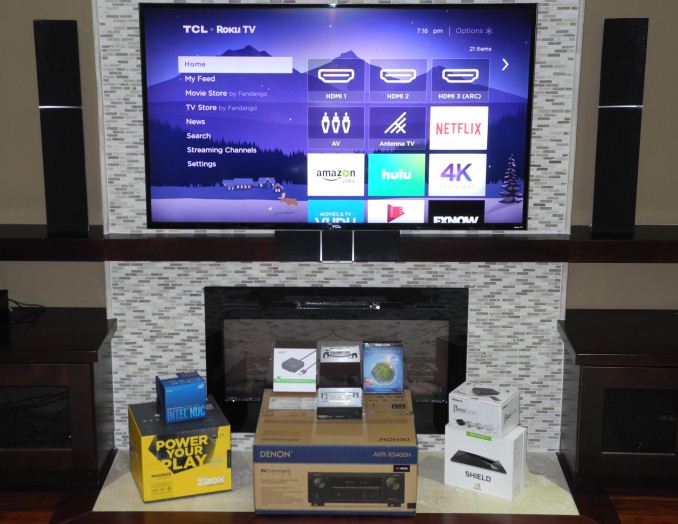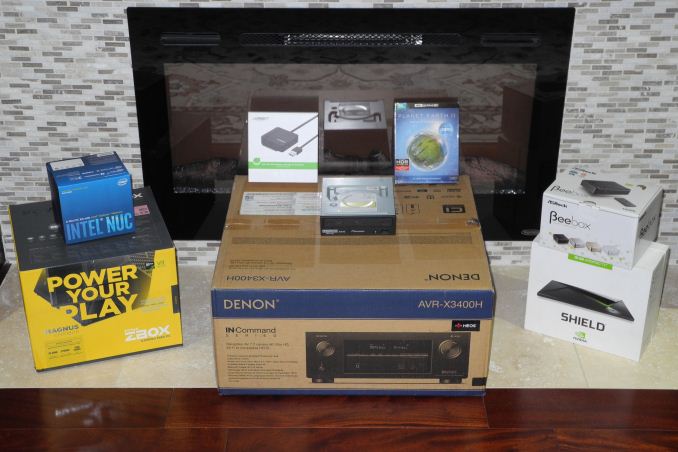A Budget Home Theater & PC Setup: 4K, HDR, UHD Blu-ray, and More
by Ganesh T S on December 26, 2017 8:30 AM EST
The days of bulky HTPCs with built-in optical drives, massive internal storage arrays, and integrated TV tuners are long gone. The advent of over the top (OTT) online streaming services has moved a lot of functionality to the cloud. As NAS units become more powerful, it has made sense to move local media files to a central repository. All these have enabled the TV-connected PC to become more compact. Unless the consumer has specific requirements (like, say, high quality gaming), even ultra-compact form factor (UCFF) machines such as the Intel NUCs can fit the bill.
Home Theater Components: Keeping up with the Times
The primary functionality of HTPCs has evolved to become one of a powerful and versatile media player. However, recent advances such as 4K and high dynamic range (HDR) videos, as well as stricter DRM requirements such as HDCP 2.2 for premium content have made the perfect HTPC platform difficult to achieve. Before delving deeper into these new advances, it is helpful to have some insight into how the landscape has changed over the last decade or so. The advancements in that timeframe have meant that next attractive home theater feature was always around the corner. In the initial days of 720p televisions and other home theater equipment, it was Full HD (1080p). As 1080p became widespread, it was HD audio bitstreaming. After that, 3D support was sought after. A brief lull ensued before the market started slowly getting ready for 4K.
Over the last year or so, we have seen the appearance of displays and audio/video receivers (AVRs) supporting HDMI 2.0 / HDCP 2.2 along with HDR / Dolby Vision. Despite the announcement of HDMI 2.1, I believe that we have reached a point where it is possible to purchase a relatively inexpensive home theater and HTPC configuration without worrying about it getting obsolete within the the next 3 to 5 years.
On the media side, OTT streaming services have become popular to the extent that Netflix and YouTube moved to offer 4K videos to consumers ahead of Blu-rays. Fortunately, many modern PCs are capable of 4K Netflix playback, though HDR is available only on a subset of those configurations. UHD Blu-ray playback support is available through CyberLink PowerDVD 17. However, the hardware requirements are a lot more specific compared to premium OTT services. UHD Blu-ray playback with HDR requires that the home theater components fulfill additional requirements.
Building a Home Theater on a Budget
I started work on this home theater piece back in June 2017. The aim was to present a setup (TV, AVR, and HTPC) with all the bells and whistles, yet light on the wallet. While the TV (TCL 55P607) and the AVR (Denon AVR X3400H) were easy to narrow down based on the feature requirements and budget, the PC side proved to be more challenging. Our core requirements (compact form factor, 4K Netflix support, and HDR capability) narrowed down the choices to a NVIDIA Pascal GPU-equipped PC or a Kaby Lake PC with HDCP 2.2 capabilities. UHD Blu-ray support further narrowed this down to certain Kaby Lake PCs with a HDMI 2.0 / HDCP 2.2 display output.
In the course of our evaluation, we found that consumer electronic (CE) equipment almost always received features ahead of HTPC platforms. Keeping this in mind, we ended up evaluating a number of options for the fulfillment of HTPC duties
- Roku Smart TV platform in the TCL 55P607
- NVIDIA SHIELD Android TV (SATV)
- Zotac ZBOX MAGNUS EN1080K
- ASRock Beebox-S 7200U
- Intel NUC7i7BNHX
Prior to looking at the performance of these options, it will be of interest to readers to delve deeper into our choice for the other home theater components. Earlier this year, I happened to embark on a house remodel, and I took that opportunity to revamp the HTPC test components used in our system reviews. Our choice of components is geared towards a typical family room (15' x 15') home theater.











191 Comments
View All Comments
ebilg - Tuesday, December 26, 2017 - link
To avoid all the headaches with UHD Bly-rays you could just get an Xbox instead. The studios don't seem to care about 4K Blu-ray on PCs. Plus the Xbox also does Hulu in 4K.ddrіver - Tuesday, December 26, 2017 - link
It's obvious the "budget setup" isn't actually a budget setup because the guy just accepts to be "sponsored" with equipment that blows any budget: it goes from ~$470 to ~$1000. That's over $500 extra. On a budget! So who cares about the BR player? It can just be sponsored by somebody.@GaneshTS & AT what other budget builds can you do with expensive sponsored stuff? I was thinking on an article on how to get free gaming builds... from your parents.
ganeshts - Tuesday, December 26, 2017 - link
Dude, seriously? The only equipment that was sponsored was the Denon AVR, and it was clearly specified. Everything else was out of my own pocket (other than the PCs that come in for review on a revolving basis)ddrіver - Tuesday, December 26, 2017 - link
That wasn't about getting hidden stuff or anything like that. It was about adding $500 and still calling it a budget build. A $1000 receiver isn't part of any budget build. It doesn't make sense.Gasaraki88 - Wednesday, December 27, 2017 - link
So you want a home theater system but don't want to get an AV receiver? You complaining about a $500 receiver? That's the cheapest you can get that supports DV passthrough and all the other new tech. If you don't want good sound you don't need a receiver so you can subtract that out but then it not a "Home Theater" then.Icehawk - Wednesday, December 27, 2017 - link
Not even remotely true, plenty of recievers in the ~$400 range offer the sams functions. After my last two $800+ recievers crapped out after two years I will no longer put my money in them.Crazyeyeskillah - Thursday, December 28, 2017 - link
You are completely out of touch with your readers. There are plenty of options on the market that will deliver a great experience without dumping $500 into a receiver. While it's fun to piss away money on a home theater system, you don't have to blow all your money on something that won't give a perceivable benefit whatsoever to the average consumer. The extra $500 could make up the difference towards a 55" OLED display, or an entry level projector. Your priorities are clearly bias and deserve to be in question. Most of your articles are fair but this is really a preposterous entry without question.I would have honestly love to seen a review of some entry level projectors. Virtually everyone wants to know more about the bulbs, longevity, brightness, clarity, and other factors. Speakers are pretty much the no brainer of tech, they either work or they don't. If you want more channels just increase the blank.1 you have setup.
Even just building a really versatile box for future proof playback would have been sufficient. People tend to geek out on their displays in their own way.
FreckledTrout - Sunday, December 31, 2017 - link
@Crazyeyeskillah, I disagree. Any adults here who can afford an OLED TV would love a decent quality home theater which will cost at minimum $2000 but many people just don't know it. My nephew who is 28 has a good soundbar system and really didn't understand why I spend $2.5K on speakers and a receiver so we watched a movie, pearl harbor. When your company leans to duck the plane dropping bombs, priceless. Good home theater isn't something most people understand but once they have heard it they know what they are missing.SunnyHours - Wednesday, July 11, 2018 - link
There are other ways of having a decent speaker system without dishing out 500$US on a "home theater" receiver...especially if you don't plan on getting a decent set of Surround Sound speakers, which are not cheap...we are talking at least another 500$ up to 2000$ or more...and just for speakers.Instead, why not get a nice set of powered Bookshelf speakers like AudioEngine, Swan, HiVi, M-Audio, Kanto, Edifier and even Klipsch have good speakers that don't need a Receiver/Amplifier and generally have a 3.5mm cable so it's compatible with most anything, there are also some who do have RCA input(s). In this list you'll find all kinds of prices and whether you want a 2.0 speaker system or a 7.2 speaker system.
Also, another nice option if you have many things to connect, you can always just get a nice and simple 2.1 Sound System with a receiver (NAD, Yamaha, Denon, Harmon Kardon and others that don't come to mind should serve you well) and a pair of regular Bookshelf Speakers (Same brands mentioned before plus a couple others...just go to your biggest audio dealer close by and try them out before you buy them...if you can try both the receiver and speakers all the better!)
The 3rd option would be to go with Headphones!
If you want to head to head, speaker system vs Headphone system...of the same price, you'll always get way more sound for your money out of a simple headphone DAC/Amplifier combo and some Headphones or a DAC, headphone Amplifier and Headphones.
Whatever you do, please, do NOT encourage Bose. They sell overpriced stuff and it's just a really bad deal all around.
If you want more information and to ask questions to people who really know their stuff, head over to the Head-Fi Forums. They really specialize in headphones, but being Audiophiles usually means you'll also want good sounding speakers to be able to share it with others, and also to mix it up a little.
prerich - Friday, July 27, 2018 - link
Bravo!!!!